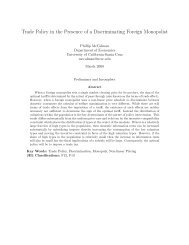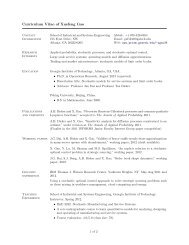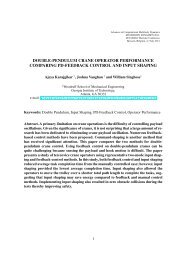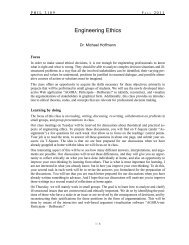Policy Improvement for Repeated Zero-Sum Games with Asymmetric ...
Policy Improvement for Repeated Zero-Sum Games with Asymmetric ...
Policy Improvement for Repeated Zero-Sum Games with Asymmetric ...
You also want an ePaper? Increase the reach of your titles
YUMPU automatically turns print PDFs into web optimized ePapers that Google loves.
<strong>Policy</strong> <strong>Improvement</strong> <strong>for</strong> <strong>Repeated</strong> <strong>Zero</strong>-<strong>Sum</strong><br />
<strong>Games</strong> <strong>with</strong> <strong>Asymmetric</strong> In<strong>for</strong>mation<br />
Malachi Jones and Jeff S. Shamma<br />
Abstract—In a repeated zero-sum game, two players repeatedly<br />
play the same zero-sum game over several stages. We<br />
assume that while both players can observe the actions of<br />
the other, only one player knows the actual game, which was<br />
randomly selected from a set of possible games according to a<br />
known distribution. The dilemma faced by the in<strong>for</strong>med player<br />
is how to trade off the short-term reward versus long-term<br />
consequence of exploiting in<strong>for</strong>mation, since exploitation also<br />
risks revelation. Classic work by Aumann and Maschler derives<br />
the recursive value equation, which quantifies this tradeoff<br />
and derives a <strong>for</strong>mula <strong>for</strong> optimal policies by the in<strong>for</strong>med<br />
player. However, using this model <strong>for</strong> explicit computations can<br />
be computationally prohibitive as the number of game stages<br />
increases. In this paper, we derive a suboptimal policy based<br />
on the concept of policy improvement. The baseline policy is a<br />
non-revealing policy, i.e., one that completely ignores superior<br />
in<strong>for</strong>mation. The improved policy, which is implemented in<br />
a receding horizon manner, strategizes <strong>for</strong> the current stage<br />
while assuming a non-revealing policy <strong>for</strong> future stages. We<br />
show that the improved policy can be computed by solving a<br />
linear program, and the computational complexity of this linear<br />
program is constant <strong>with</strong> respect to the length of the game. We<br />
derive bounds on the guaranteed per<strong>for</strong>mance of the improved<br />
policy and establish that the bounds are tight.<br />
I. INTRODUCTION<br />
We consider an asymmetric zero-sum game, in which one<br />
player is in<strong>for</strong>med about the true state of the world. This state<br />
determines the specific game that will be played repeatedly.<br />
The other player, the unin<strong>for</strong>med player, has uncertainty<br />
about the true state. Since both players can observe the<br />
actions of their opponent, the unin<strong>for</strong>med player can use his<br />
observations of the in<strong>for</strong>med player’s actions to estimate the<br />
true state of the world. Exploiting/revealing in<strong>for</strong>mation to<br />
achieve a short-term reward risks helping the unin<strong>for</strong>med<br />
player better estimate the true state of the world. A better<br />
estimate of the true state can allow the unin<strong>for</strong>med player to<br />
make better decisions that will cost the in<strong>for</strong>med player over<br />
the long term. A natural question is how should the in<strong>for</strong>med<br />
player exploit his in<strong>for</strong>mation.<br />
Aumann and Maschler [1] introduced a recursive <strong>for</strong>mulation<br />
that characterizes the optimal payoff the in<strong>for</strong>med player<br />
can achieve, which is referred to as the value of the game.<br />
This <strong>for</strong>mulation evaluates the tradeoff between short-term<br />
rewards and long-term costs <strong>for</strong> all possible decisions of the<br />
in<strong>for</strong>med player, and the optimal decision is the decision<br />
This research was supported by ARO/MURI Project W911NF-09-1-0553.<br />
M. Jones and J.S. Shamma are <strong>with</strong> the School of Electrical and Computer<br />
Engineering, College of Engineering, Georgia Institute of Technology<br />
{kye4u, shamma}@gatech.edu<br />
that provides the best overall game payoff. Determining the<br />
optimal decision becomes increasingly difficult as the length<br />
of the game grows. There<strong>for</strong>e, computing an optimal decision<br />
<strong>for</strong> games of non-trivial lengths can be computational<br />
prohibitive. This difficulty extends also to the simplest zerosum<br />
games, which have two states and two possible actions<br />
<strong>for</strong> each player in a given state.<br />
Much of the current work to address the in<strong>for</strong>mation<br />
exploitation issue, which includes the work of Domansky<br />
and Kreps [2] and Heur [3], has been limited to finding<br />
optimal strategies <strong>for</strong> special cases of the simplest zerosum<br />
games. Zamir provided a method to generate optimal<br />
strategies under certain conditions <strong>for</strong> 2x2 and 3x3 matrix<br />
games [4]. Gilpin and Sandholm [5] propose an algorithm<br />
<strong>for</strong> computing strategies in games by using a non-convex<br />
optimization <strong>for</strong>mulation <strong>for</strong> only the infinitely repeated case.<br />
There is work that considers using suboptimal strategies to<br />
address the in<strong>for</strong>mation exploitation issue <strong>for</strong> all classes of<br />
games [6]. In this work, the in<strong>for</strong>med player never uses his<br />
in<strong>for</strong>mation throughout the game, and accordingly is “nonrevealing.”<br />
While the suboptimal strategies are readily computable,<br />
only under special circumstances do these strategies<br />
offer strong suboptimal payoffs.<br />
In this paper, after introducing basic repeated zero-sum<br />
game concepts and definitions, we introduce a suboptimal<br />
strategy that we refer to as the one-time policy improvement<br />
strategy. We show that the computational complexity of constructing<br />
this strategy is constant <strong>with</strong> respect to the length<br />
of game. Next, we provide tight bounds on the guaranteed<br />
per<strong>for</strong>mance of the constructed suboptimal policy. We then<br />
show that the policy improvement strategy can be computed<br />
by solving a linear programing problem. Finally, we present<br />
an illustrative simulation.<br />
II.<br />
ZERO-SUM DEFINITIONS AND CONCEPTS<br />
In this section, we will introduce basic zero-sum repeated<br />
game definitions relevant to this paper. The first and most<br />
important concept is Aumann and Maschler’s dynamic programming<br />
equation <strong>for</strong> evaluating the tradeoff between shortterm<br />
and long-term payoff. We will then discuss the notion<br />
of non-revealing strategies, which will be exploited in our<br />
construction of suboptimal policies to reduce computational<br />
complexity.
A. Setup<br />
1) Game Play: Two players repeatedly play a zero-sum<br />
matrix game over stages m = 1, 2, ..., N. The row player<br />
is the maximizer, and the column player is the minimizer.<br />
The specific game is selected from a finite set of possible<br />
games (or states of the world), K. Let ∆(L) denote the set<br />
of probability distributions over some finite set, L. Define S<br />
to be the set of pure actions of the row player, and similarly<br />
define J to be the set of pure actions of the column player.<br />
The game matrix at state k ∈ K is denoted M k ∈ R |S|×|J| .<br />
Be<strong>for</strong>e stage m = 1, nature selects the specific game<br />
according to a probability distribution p ∈ ∆(K), which is<br />
common knowledge. This selection remains fixed over all<br />
stages. The row player is in<strong>for</strong>med of the outcome, whereas<br />
the column player is not.<br />
2) Strategies: Mixed strategies are distributions over pure<br />
strategies <strong>for</strong> each player. Since the row player is in<strong>for</strong>med<br />
of the state of the world, he is allowed a mixed strategy <strong>for</strong><br />
each state k. Let x k m ∈ ∆(S) denote the mixed strategy of<br />
the row player in state k at stage m and also denote x k m(s)<br />
to be the probability that the column player plays pure move<br />
s at stage m and state k. In repeated play, this strategy can<br />
be a function of the actions of both players during stages<br />
1, ..., m − 1. Likewise, let y m ∈ ∆(J) denote the mixed<br />
strategy of the column player at stage m, which again can<br />
depend on the players’ actions over stages 1, ..., m − 1.<br />
Let x m = { x 1 m , ..., m} xK denote the collection of the row<br />
player’s mixed strategies <strong>for</strong> all states at stage m, and<br />
x = {x 1 , ..., x m } denote mixed strategies over all states<br />
and stages. Likewise, let y = {y 1 , .., y m } denote the column<br />
player’s mixed strategies over all stages.<br />
Define H m = [S × J] m−1 to be the set of possible<br />
histories where an element h m ∈ H m is a sequence<br />
(s 1 , j 1 ; s 2 , j 2 ; ...; s m−1 , j m−1 ) of the players’ moves in the<br />
first m −1 stages of the game, and let h I m denote the history<br />
of player 1’s moves. Each player can perfectly observe the<br />
moves of the other player. There<strong>for</strong>e, the histories of each<br />
player at stage m are identical. Behavioral strategies are<br />
mappings from states and histories to mixed strategies. Let<br />
σ n : k × h n → ∆(S) denote a behavioral strategy of the<br />
row player and denote ˆσ m k [h](s) to be the probability that<br />
the column player plays pure move s at stage m, history<br />
h, and state k. The column player’s behavioral strategy can<br />
only depend on histories and is denoted by τ n : h n → ∆(J).<br />
Define σ = {σ 1 , ..., σ n } to be the collection of behavioral<br />
strategies of the row player over all stages. Likewise, define<br />
τ = {τ 1 , ..., τ n } to be the collection of behavioral strategies<br />
of the column player over all stages. Aumann established<br />
that behavioral strategies can be equivalently represented as<br />
mixed strategies [7].<br />
3) Beliefs: Since the column player is not in<strong>for</strong>med of<br />
the selected state k, he can build beliefs on which state was<br />
selected. These beliefs are a function of the initial distribution<br />
p and the observed moves of the row player. There<strong>for</strong>e, the<br />
row player must carefully consider his actions at each stage<br />
as they could potentially reveal the true state of the world to<br />
the column player. In order to get a worse case estimate of<br />
how much in<strong>for</strong>mation the row player transmits through his<br />
moves, he models the column player as a Bayesian player<br />
and assumes that the column player has his mixed strategy.<br />
The updated belief p + is computed as<br />
p + (p, x, s) = pk x k (s)<br />
¯x(p, x, s) , (1)<br />
where ¯x(p, x, s) := ∑ k∈K pk x k (s) and x k (s) is the probability<br />
of playing pure action s at state k.<br />
4) Payoffs: Let γm(σ, p τ)=E [g m ] p,σ k ,τ<br />
denote the expected<br />
payoff <strong>for</strong> the pair of behavioral strategies (σ, τ) at<br />
stage m. The payoff <strong>for</strong> the n-stage game is then defined as<br />
¯γ p n (σ, τ) = 1 n<br />
n∑<br />
m=1<br />
γm p (σ, τ). (2)<br />
Similarly the payoff <strong>for</strong> the λ-discounted game is defined as<br />
¯γ p λ (σ, τ) = ∞ ∑<br />
m=1<br />
B. Short-term vs long-term tradeoff<br />
λ(1 − λ) m−1 γm p (σ, τ). (3)<br />
The dynamic programming recursive <strong>for</strong>mula<br />
[<br />
v n+1 (p) = 1 ∑<br />
maxmin<br />
p k x k<br />
n + 1 x 1 y 1<br />
1M k y 1<br />
+ n ∑ s∈S<br />
k∈K<br />
¯x s v n<br />
(p + (p, x 1 , s)) ] (4)<br />
introduced by Aumann and Maschler [1] characterizes the<br />
value of the zero-sum repeated game of incomplete in<strong>for</strong>mation.<br />
Note that n is a non-negative integer and <strong>for</strong> the case<br />
where n = 0, the problem reduces to<br />
v 1 (p) = max<br />
x 1<br />
min<br />
y 1<br />
∑<br />
p k x k 1M k y 1 , (5)<br />
k∈K<br />
which is the value of the 1-shot zero-sum incomplete in<strong>for</strong>mation<br />
game.<br />
A key interpretation of this <strong>for</strong>mulation is that it also<br />
serves as a model of the tradeoff between short-term gains<br />
and the long-term in<strong>for</strong>mational advantage. For each decision<br />
x 1 of the in<strong>for</strong>med player, the model evaluates the payoff<br />
<strong>for</strong><br />
∑<br />
the current stage, which is represented by the expression<br />
k∈K pk x k 1 Mk y 1 , and the long-term cost <strong>for</strong> decision x 1 ,<br />
which is represented by n ∑ )<br />
s∈S ¯x sv n<br />
(p + (p, x 1 , s) .<br />
It is worth pointing out that the computational complexity<br />
<strong>for</strong> finding the optimal decision x ∗ 1 can be attributed to the<br />
cost of calculating the long-term payoff. Since the long-term<br />
payoff is a recursive optimization problem that grows <strong>with</strong><br />
respect to the game length, it can be difficult to find optimal<br />
strategies <strong>for</strong> games of arbitrary length. This difficulty is<br />
because the number of decision variables in the recursive<br />
optimization problem grows exponentially <strong>with</strong> respect to the<br />
game length. Ponssard and Sorin [8] showed that zero-sum
epeated games of incomplete in<strong>for</strong>mation can be <strong>for</strong>mulated<br />
as a linear program (LP) to compute optimal strategies.<br />
However, in the LP <strong>for</strong>mulation, it can be immediately seen<br />
that the computational complexity is also exponential <strong>with</strong><br />
respect to the game length. One of the goals of this research<br />
is to present a method to compute suboptimal policies <strong>with</strong><br />
tight lower bounds, and a feature of this method is that its<br />
computational complexity remains constant <strong>for</strong> games of any<br />
length.<br />
C. Non-revealing strategies<br />
Revealing in<strong>for</strong>mation is defined as using a different mixed<br />
strategy in each state k at stage m. From (1), it follows<br />
that a mixed strategy x m at stage m does not change the<br />
current beliefs of the row player if x k m = x k′<br />
m ∀ k, k ′ . As a<br />
consequence, not revealing in<strong>for</strong>mation is equivalent to not<br />
changing the column player’s beliefs about the true state of<br />
the world. In stochastic games, it is possible <strong>for</strong> the column<br />
player’s beliefs to change even if the row player uses an<br />
identical mixed strategy <strong>for</strong> each state k.<br />
An optimal non-revealing strategy can be computed by<br />
solving<br />
u(p) = max min<br />
∑<br />
p k x k M k y, (6)<br />
x∈NR y<br />
where the set of non-revealing strategies is defined as NR =<br />
{x m | x k m = xm k′ ∀k, k ′ ∈ K}. By playing an optimal nonrevealing<br />
strategy at each stage of the game, the row player<br />
can guarantee a game payoff of u(p). Note that the optimal<br />
game payoff <strong>for</strong> the n-stage game, v n (p), is equal to u(p)<br />
only under special conditions.<br />
III. POLICY IMPROVEMENT STRATEGY<br />
We have previously stated in Section II-B that the difficulty<br />
in explicitly computing optimal strategies <strong>for</strong> an arbitrary<br />
game grows exponentially <strong>with</strong> respect to the number of<br />
stages in the game. In this paper, we consider suboptimal<br />
strategies whose computational complexity remains constant<br />
<strong>for</strong> games of arbitrary length. One such strategy that we introduce<br />
is called one-time policy improvement. In incomplete<br />
in<strong>for</strong>mation games, the row player always has the option of<br />
not using his superior in<strong>for</strong>mation. A “simple” policy <strong>for</strong> the<br />
n-stage game would be <strong>for</strong> the row player to never use his<br />
superior in<strong>for</strong>mation. As noted in Section II-C, if he uses such<br />
a policy, he can only guarantee a payoff of at most u(p). In<br />
a one-time policy improvement strategy, the “simple” policy<br />
becomes the baseline policy. The key difference is that <strong>with</strong><br />
the one-time policy improvement strategy, the row player is<br />
allowed to deviate from the “simple” policy at the first stage<br />
of the game. After the first stage, he is obliged to use the<br />
“simple” policy <strong>for</strong> the next n-1 stages.<br />
The guaranteed payoff <strong>for</strong> the one-time policy improvement<br />
strategy <strong>for</strong> the n-stage game is denoted by ˆv n (p).<br />
Determining ˆv n (p) can be achieved by solving<br />
ˆv n (p) = 1 n<br />
[<br />
∑<br />
max min p k x k<br />
x 1 y<br />
1 Mk y 1<br />
1<br />
+ (n − 1) ∑ s∈S<br />
(<br />
¯x s u p + (p, x 1 , s)) ] (7)<br />
<strong>for</strong> n ≥ 1.<br />
Definition 1: Let cav u(p) denote the point-wise smallest<br />
concave function g on ∆(K) satisfying g(p) ≥ u(p) ∀p ∈<br />
∆(K).<br />
Definition 2: Denote the one-time policy improvement behavioral<br />
strategy by ˆσ, where <strong>for</strong> each ˆσ m≥2 , let ˆσ m(h)[s] k =<br />
ˆσ m k′ (h)[s] ∀k, k′ ∈ K.<br />
Definition 3: A perpetual policy improvement strategy is<br />
a strategy that is implemented in a receding horizon manner<br />
and strategizes <strong>for</strong> the current stage while assuming a nonrevealing<br />
policy <strong>for</strong> future stages.<br />
Theorem 1: One-time policy improvement guarantees a<br />
payoff of at least cav u(p) <strong>for</strong> the n-stage zero-sum repeated<br />
games of incomplete in<strong>for</strong>mation on one-side.<br />
Proof: We will devote the remainder of this section to<br />
the proof of this theorem. The proof will proceed as follows.<br />
1) We will first prove in Proposition 3.5 that <strong>for</strong> any<br />
initial distribution p there exists a one-time policy<br />
improvement behavioral strategy whose lower bound is<br />
greater than or equal to ∑ l∈L α lu(p l ), where |L| < ∞,<br />
α ∈ ∆(L), p, p l ∈ ∆(K), and p = ∑ l∈L α lp l .<br />
2) Next we note that cav u(p) = ∑ e∈E α eu(p e ), where<br />
α ∈ ∆(E), |E| < ∞, p, p e ∈ ∆(K), and p =<br />
∑<br />
e∈E α ep e .<br />
3) It then follows that the one-time policy improvement<br />
behavioral strategy has a lower bound of cav u(p),<br />
which is tight.<br />
4) Recall that behavioral strategies can be equivalently<br />
represented as mixed strategies. There<strong>for</strong>e a one-time<br />
policy improvement behavioral strategy can be equivalently<br />
represented as a one-time policy improvement<br />
mixed strategy. As a consequence ˆv n (p) ≥ cav u(p)<br />
Corollary 2: Perpetual policy improvement guarantees a<br />
payoff of at least cav u(p) <strong>for</strong> the n-stage zero-sum repeated<br />
games of incomplete in<strong>for</strong>mation on 1-side.<br />
Proof: This can be shown by using standard dynamic<br />
programming arguments regarding policy improvement.<br />
Lemma 3.1: [9] Let L be a finite set and p = ∑ l∈L α lp l<br />
<strong>with</strong> α ∈ ∆(L) , and p,p l ∈ ∆(K) <strong>for</strong> all l in L Then there<br />
exists a transition probability µ from (K, p) to L such that<br />
P(l) = α l and P(·|l) = p l ,<br />
where P = p · x is the probability induced by p and µ on<br />
K × L : P(k, l) = p k µ k (l).<br />
Lemma 3.2: Fix p arbitrarily. Let p be represented as p =<br />
∑<br />
l∈L α lp l , where |L| < ∞, α ∈ ∆(L), and p,p l ∈ ∆(K)
Then their exists a strategy σ, which will be referred to as<br />
the splitting strategy, such that<br />
¯γ p n (σ, τ) ≥ ∑ l∈L<br />
α l u(p l ) ∀τ (8)<br />
Proof:<br />
1) Introduce strategy σ as follows. Let σ l be the strategy<br />
that guarantees u(p l ) <strong>for</strong> the n-stage game. Define<br />
µ k p<br />
(l) = α k l l . If the state is k, use the lottery µ k ,<br />
p k<br />
and if the outcome is l, play σ l .<br />
2) To get a lower bound on Player 1’s payoff, assume<br />
even that Player 2 is in<strong>for</strong>med upon l. He is then facing<br />
strategy σ l<br />
3) By Lemma 3.1, this occurs <strong>with</strong> probability α l and the<br />
conditional probability on K is p l , hence the game is<br />
γ p l<br />
n , so that ¯γ n(σ, p τ) ≥ ∑ l∈L α lu(p l ) ∀τ<br />
Lemma 3.3: Consider mixed strategy ˜x, where ˜x =<br />
{˜x 1 , ˜x 2 , ..., ˜x |K| }. There exists a one-time policy improvement<br />
behavioral strategy ˆσ where ˆσ m(s) k = ˜x k (s) ∀ k.<br />
Proof:<br />
1) Consider the following behavioral strategy. At stage<br />
m = 1, Player 1 uses mixed strategy ˜x k , where k is<br />
the true state of the world (i.e. ˆσ 1 : k × {∅} ↦→ ˜x k ).<br />
Whatever move s ′ ∈ S that is realized in stage m = 1,<br />
Player 1 plays s ′ at each stage <strong>for</strong> the remainder of the<br />
game (i.e. σˆ<br />
n : h m−1 ↦→ h 1 where m ≥ 2 and h m−1<br />
is player 1’s history at stage m − 1 ).<br />
2) Clearly ˆσ 1(s) k = ˜x k (s) by definition.<br />
3) Consider stage 2. Suppose the probability of playing<br />
move s ′ in state k at stage 1 is α. Recall that whatever<br />
move that the row player realizes in stage 1 is played<br />
<strong>for</strong> the rest of the game. It follows that if the state of<br />
world is state k, the probability of playing move s ′ in<br />
stage 2 is also α.<br />
4) The same argument can be applied to stage m.<br />
5) We have now established that the following equality<br />
ˆσ m k (s) = ˜xk (s) holds <strong>for</strong> all m, where ˆσ is the onetime<br />
policy improvement behavioral strategy.<br />
Proposition 3.4: Fix p arbitrarily. Let p be represented as<br />
p = ∑ l∈L α lp l , where |L| < ∞ , α ∈ ∆(L) , and p,p l<br />
∈ ∆(K). Suppose we construct a behavioral strategy ¯σ as<br />
follows. Define σ l to be the optimal behavioral strategy to the<br />
non-revealing n-stage game u(p l ). Let ¯σ k = ∑ l∈L µk (l)σl<br />
k<br />
define the mixed behavioral strategy <strong>for</strong> the n-stage game,<br />
where µ k p<br />
(l) = α k l l . The lower bound <strong>for</strong> the payoff of<br />
p k<br />
behavioral strategy ¯σ is ∑ l∈L α lu(p l ). Explicitly<br />
¯γ p n (¯σ, τ) = ∑ k∈K<br />
p k [ 1<br />
n<br />
= 1 ∑<br />
[<br />
∑ n<br />
∑<br />
p k<br />
n<br />
k∈K<br />
m=1 l∈L<br />
n∑<br />
]<br />
E [g m ] k,¯σk ,τ<br />
m=1<br />
]<br />
µ k (l)E [g m ] k,σ k<br />
l ,τ<br />
(9)<br />
≥ ∑ l∈L<br />
α l u(p l ) ∀τ<br />
where τ is the behavioral strategy of player 2<br />
Proof: We will first establish that the splitting strategy<br />
has the equivalent payoff of mixed behavioral strategy ¯σ<br />
<strong>for</strong> arbitrary behavioral strategies τ of the column player.<br />
We then note that the splitting strategy has a lower bound<br />
of ∑ l∈L α lu(p l ). We conclude by making the following<br />
observation. Since the splitting strategy has an identical<br />
payoff as strategy ¯σ <strong>for</strong> each strategy τ, it also has the same<br />
lower bound ∑ l∈L α lu(p l ).<br />
1) Recall the splitting strategy as defined in Lemma 3.2.<br />
2) The payoff <strong>for</strong> this strategy can be expressed as follows:<br />
[<br />
∑ ∑<br />
p k µ k 1<br />
(l)<br />
n<br />
k∈K l∈L<br />
n∑<br />
m=1<br />
= 1 ∑<br />
p ∑ [<br />
∑ n k µ k (l)<br />
n<br />
k∈K l∈L m=1<br />
= 1 n<br />
∑<br />
k∈K<br />
p k<br />
n ∑<br />
∑<br />
m=1 l∈L<br />
]<br />
E [g m ] k,σ k<br />
l ,τ<br />
]<br />
E [g m ] k,σ k<br />
l ,τ<br />
µ k (l)E [g m ] k,σ k<br />
l ,τ (10)<br />
3) Observe that the payoff <strong>for</strong> strategy ¯σ in (9) is equivalent<br />
to the payoff <strong>for</strong> the splitting strategy σ in (10)<br />
<strong>for</strong> arbitrary τ. Explicitly ¯γ p n(¯σ, τ) = ¯γ p n(σ, τ) ∀τ.<br />
4) Recall Lemma 3.2, which states that the splitting strategy<br />
has a payoff <strong>with</strong> lower bound ∑ l∈L α lu(p l ).<br />
5) Conclusion: Given a behavioral strategy τ of player<br />
2, we have established that the payoff of strategy ¯σ<br />
is equivalent to that of the splitting strategy. We show<br />
that the payoff of splitting strategy is lower bounded<br />
by ∑ l∈L α lu(p l ). This implies that strategy ¯σ also has<br />
this lower bound.<br />
Proposition 3.5: There exists a one-time policy improvement<br />
strategy ˆσ such that the following inequality holds.<br />
¯γ p n(ˆσ, τ) ≥ ∑ l∈L<br />
α l u(p l )<br />
Proof:<br />
1) Recall the mixed behavioral strategy ¯σ as defined in<br />
Proposition 3.4, where ¯σ k = ∑ l∈L µk (l)σl k.<br />
2) Note first that since σ l is an optimal non-revealing<br />
strategy, behavioral strategy σl k is the same <strong>for</strong> every<br />
state k (i.e. σl k = σl<br />
k′ ∀k, k ′ ). Furthermore, the NR<br />
mixed strategy x ∗ l is constant <strong>for</strong> each stage<br />
3) There<strong>for</strong>e σl k n<br />
= x ∗ l<br />
∀k, ∀n.<br />
4) Define α k = ∑ l∈L µk (l)x ∗ l .<br />
5) We can then express ¯σ n as ¯σ n : K ×H n−1 ↦→ α k ∀n,<br />
which is a stationary strategy.<br />
6) Define ˜x as follows: ˜x = {α 1 , α 2 , ..., α |K| }.
7) By Lemma 3.3, there exists a one-time policy improvement<br />
strategy ˆσ such that ˆσ k m (s) = ˜xk (s) ∀ s, m<br />
8) We have now established that ¯γ p n(ˆσ, τ) = ¯γ p n(¯σ, τ) ∀ τ<br />
9) There<strong>for</strong>e it follows that<br />
¯γ p n (ˆσ, τ) = ¯γp n (¯σ, τ) ≥ ∑ l∈L<br />
α l u(p l ) ∀τ (11)<br />
IV. POLICY IMPROVEMENT IN INFINITE HORIZON GAMES<br />
In the previous section, we have shown that the one-time<br />
policy improvement strategy guarantees cav u(p) <strong>for</strong> the n-<br />
stage game. In this section we will show that the guarantee<br />
also holds in the infinite horizon games. The guaranteed<br />
payoff <strong>for</strong> the one-time policy improvement strategy in the<br />
λ-discounted infinite horizon games can be computed by<br />
solving<br />
{<br />
maxmin<br />
λ ∑ p k x k<br />
x 1 y<br />
1 Mk y 1<br />
1<br />
+ (1 − λ) ∑ ( )}<br />
¯x s u p + (p, x 1 , s)<br />
s∈S<br />
(12)<br />
<strong>for</strong> λ ∈ (0, 1).<br />
Theorem 3: One-time policy improvement guarantees a<br />
payoff of at least cav u(p) <strong>for</strong> the λ-discounted infinite<br />
horizon zero-sum repeated games of incomplete in<strong>for</strong>mation<br />
on one-side.<br />
Proof: We will show the existence of a one-time policiy<br />
improvement strategy that guarantees at least cav u(p).<br />
1) Fix λ ∈ (0, 1) arbitrarily.<br />
2) There exists N ′ s.t. λ > 1 N ′ . Consider this N ′ .<br />
3) Let ˜λ = 1 N ′ , then ˆv˜λ(p) = ˆv N ′(p).<br />
4) Invoking Theorem 1 yields ˆv˜λ(p) = ˆv N ′(p) ≥ cav u(p)<br />
5) Claim: The optimal one-time policy improvement<br />
strategy <strong>for</strong> the discounted game ˆv˜λ(p) also guarantees<br />
at least cav u(p) <strong>for</strong> ˆv λ (p).<br />
Proof:<br />
Since ˆv˜λ(p) ≥ cav u(p) and ∑ s∈S ¯x su(p + | x 1 , s) ≤<br />
cav u(p), it follows that the optimal stage 1 strategy<br />
∑<br />
x ∗ 1 <strong>for</strong> ˆv˜λ(p) has the following lower bound:<br />
p k x k ∗<br />
1 M k y 1 ≥ cav u(p). Note that λ > ˜λ. There<strong>for</strong>e<br />
λ ∑ p k x k ∗<br />
1 M k y 1 + (1 − λ) ∑ ( )<br />
¯x s u p + (p, x 1 , s)<br />
s∈S<br />
≥ ˜λ ∑ p k x k ∗<br />
1 M k y 1 + (1 − ˜λ) ∑ ( )<br />
¯x s u p + (p, x 1 , s)<br />
s∈S<br />
≥ cav u(p).<br />
Remark: If ∑ s∈S ¯x su(p + (p, x ∗ 1, s)) = cav u(p) and<br />
∑ p k x k ∗<br />
1 M k y 1 = cav u(p) then ˆv λ (p) = ˆv˜λ(p) =<br />
cav u(p).<br />
6) By using the optimal stage 1 strategy x ∗ 1 obtained from<br />
ˆv˜λ(p) and playing an optimal non-revealing strategy<br />
thereafter, we have constructed a one-time policy update<br />
strategy <strong>for</strong> ˆv λ (p) that guarantees cav u(p).<br />
Theorem 4: One-time policy improvement is an optimal<br />
strategy <strong>for</strong> infinitely-repeated zero-sum games of incomplete<br />
in<strong>for</strong>mation on one-side.<br />
Proof: Using an argument similar to that of Theorem 3,<br />
one can establish that there exists a one-time policy improvement<br />
strategy that guarantees a payoff of at least cav u(p).<br />
Note that cav u(p) is the optimal payoff <strong>for</strong> the infinitelyrepeated<br />
game.<br />
V. LP FORMULATION<br />
A one-time policy-improvement strategy that guarantees<br />
cav u(p) can be computed by solving a linear programing<br />
problem, and the computational complexity of the linear<br />
program is constant <strong>with</strong> respect to the number of stages<br />
of the game.<br />
The following outlines a procedure to construct the appropriate<br />
linear program.<br />
1) Let ˜Σ denote the set of “pure” one-time policyimprovement<br />
behavioral strategies (i.e. ˜σ 1 : k ↦→ s,<br />
˜σ m : h I 1 ↦→ s ∀m ≥ 2, and ˜σ m = ˜σ m ′ ∀m, m ′ )<br />
2) Let ˜T denote the set of “pure” strategies <strong>for</strong> the<br />
unin<strong>for</strong>med player. (i.e. ˜τ 1 : ∅ ↦→ j, ˜σ m : h I 1 ↦→ j<br />
∀m ≥ 2, and ˜τ m = ˜τ m ′ ∀m, m ′ )<br />
3) Note that the size of the strategy sets ˜Σ and ˜T are<br />
invariant <strong>with</strong> respect to the number of stages of the<br />
game.<br />
4) Observe that since a one-time policy-improvement<br />
strategy is used, the strategy and the corresponding<br />
payoff remains constant <strong>for</strong> m ≥ 2, so that γm(˜σ, p ˜τ) =<br />
γ p 2 (˜σ, ˜τ) ∀m ≥ 2.<br />
5) There<strong>for</strong>e, the game payoff <strong>for</strong> the strategy pair is<br />
˜γ p λ (˜σi , ˜τ l ) = λγ p 1 (˜σi , ˜τ l ) + (1 − λ)γ p 2 (˜σi , ˜τ l ). For the<br />
n-stage game, set λ = 1 n .<br />
6) Consider a matrix M, where element (i, l) denotes the<br />
game payoff ˜γ p λ (˜σi , τ l ) <strong>for</strong> the strategy pair (˜σ i , ˜τ l ).<br />
7) Since this is a zero sum game <strong>with</strong> finite strategies <strong>for</strong><br />
each player and a payoff matrix M, a classic zero-sum<br />
game result can be used to solve this zero-sum game<br />
as a LP.<br />
As a consequence, a perpetual policy-improvement strategy<br />
that guarantees cav u(p) can be computed by solving a<br />
linear programing problem at each stage of the game, and the<br />
computational complexity of the linear program is constant<br />
<strong>with</strong> respect to the number of stages of the game.<br />
The following outlines a procedure <strong>for</strong> this construction.<br />
1) Note that the stage 1 behavioral strategy σ 1 is the onetime<br />
policy-improvement strategy that can be computed<br />
by solving a LP.<br />
2) Consider stage 2. Since this is a game of perfect<br />
recall, the behavioral strategy σ 1 can be equivalently<br />
represented as a mixed strategy x 1 .
3) A move of player 1 was realized in stage 1, and<br />
since the mixed strategy x 1 is known, the posterior<br />
probability p + can be computed.<br />
4) Compute the stage 2 strategy by solving the optimization<br />
problem ˆv λ (p + ). If it is a n-stage game, set<br />
λ = 1<br />
N−1 .<br />
5) The same techniques that was used to compute the<br />
Stage 1 strategy by solving a LP, can be used <strong>for</strong> Stage<br />
2.<br />
6) By a similar argument, the Stage m strategy can be<br />
computed by solving a LP.<br />
VI. SIMULATION: CYBER SECURITY EXAMPLE<br />
The network administrator, the row player, manages two<br />
web applications wapp 1 and wapp 2 (i.e. e-mail and remote<br />
login). Each web application is run on its own dedicated<br />
server (H 1 and H 2 ). The attacker would like to prevent users<br />
from accessing the web applications via a Denial of Service<br />
(DOS) attack. In order to help mitigate DOS attacks, a spare<br />
server (H spare ) can be dynamically configured daily to also<br />
run either wapp 1 or wapp 2 . We assume that the attacker can<br />
observe which web application the network admin decides to<br />
run on the spare server. The attacker has a choice of which<br />
web application to execute a Denial of Service.<br />
wapp 1 wapp 2<br />
wapp 1 0 1<br />
wapp 2 0<br />
1<br />
2<br />
State α<br />
wapp 1 wapp 2<br />
1<br />
wapp 1 2<br />
0<br />
wap 2 1 0<br />
State β<br />
In state α, all of the legitimate users on the network are<br />
using only wapp 1 . Conversely in state β, they are all only<br />
using wapp 2 . The payoff <strong>for</strong> each of the states are in terms<br />
of of quality of service. Suppose that p α = .5 and p β = .5,<br />
where p α denotes the initial probability of being in state α<br />
and let p = (p α , p β ). In this example, we will set the number<br />
of stages of the game to 2. If the network admin. plays his<br />
dominant strategy on day 1, he will have fully revealed the<br />
state of the network to the attacker on day 2. The dominant<br />
strategy <strong>for</strong> the network admin. is to run web application 1<br />
on the backup server in state α and to run web application 2<br />
on the backup server in β. The network admin. will achieve<br />
an expected payoff of 0.5 on day 1 and a payoff of 0 on day<br />
2 <strong>for</strong> a total payoff of .25.<br />
If the network admin uses a 1-time policy improvement<br />
strategy, will he do better? Solving numerically we compute<br />
a mixed strategy of x α = (0.50, .50) and x β = (.50, .50),<br />
<strong>with</strong> an expected game payoff of 0.375 over the two day<br />
period. Suppose, on day 2 that the network admin. decides<br />
to again improve upon the baseline policy of playing nonrevealing.<br />
By exploiting his in<strong>for</strong>mation on day 2, he can<br />
yield an expected stage payoff of .50 and a game payoff of<br />
.4375.<br />
VII. CONCLUSION<br />
Computing optimal strategies <strong>for</strong> zero-sum repeated games<br />
<strong>with</strong> asymmetric in<strong>for</strong>mation can be computationally prohibitive.<br />
Much of the current work to address this issue has<br />
been limited to special cases. In this work, we present policy<br />
improvement methods to compute suboptimal strategies that<br />
have tight lower bounds. We show that the policy improvement<br />
strategy can be computed by solving a linear program,<br />
and the computational complexity of the linear program<br />
remains constant <strong>with</strong> respect to the number of stages in the<br />
game.<br />
In this paper, we focused on computational results <strong>for</strong><br />
repeated games, where the state of the world remains fixed<br />
once it has been selected by nature. <strong>Repeated</strong> games are a<br />
special case of stochastic games. In stochastic games, the<br />
state of the world can change at each stage of the game<br />
and the state transitions can be a function of the actions of<br />
the players. We would like to consider computational results<br />
<strong>for</strong> stochastic games and also extend our current results to<br />
stochastic games.<br />
REFERENCES<br />
[1] R. J. Aumann and M. Maschler, <strong>Repeated</strong> <strong>Games</strong> <strong>with</strong> Incomplete<br />
In<strong>for</strong>mation. MIT Press, 1995.<br />
[2] V. C. Domansky and V. L. Kreps, “Eventually revealing repeated games<br />
of incomplete in<strong>for</strong>mation,” International Journal of Game Theory,<br />
vol. 23, pp. 89–109, 1994.<br />
[3] M. Heur, “Optimal strategies <strong>for</strong> the unin<strong>for</strong>med player,” International<br />
Journal of Game Theory, vol. 20, pp. 33–51, 1991.<br />
[4] S. Zamir, “On the relation between finitely and infinitely repeated<br />
games <strong>with</strong> incomplete in<strong>for</strong>mation,” International Journal of Game<br />
Theory, vol. 23, pp. 179–198, 1971.<br />
[5] A. Gilpin and T. Sandholm, “Solving two-person zero-sum repeated<br />
games of incomplete in<strong>for</strong>mation,” International Joint Conference on<br />
Autonomous Agents and Multiagent Systems, vol. 2, pp. 903–910, 2008.<br />
[6] S. Zamir, “<strong>Repeated</strong> games of incomplete in<strong>for</strong>mation: <strong>Zero</strong>-sum,”<br />
Handbook of Game Theory, vol. 1, pp. 109–154, 1999.<br />
[7] R. Aumann, Mixed and behavior strategies in infinite extensive games.<br />
Princeton University, 1961.<br />
[8] J. Ponssard and S. Sorin, “The l-p <strong>for</strong>mulation of finite zero-sum games<br />
<strong>with</strong> incomplete in<strong>for</strong>mation,” International Journal of Game Theory,<br />
vol. 9, pp. 99–105, 1999.<br />
[9] S. Sorin, A First Course on <strong>Zero</strong>-<strong>Sum</strong> <strong>Repeated</strong> <strong>Games</strong>. Springer,<br />
2002.<br />
[10] D. Blackwell, “An analog of the minimax theorem <strong>for</strong> vector payoffs.”<br />
Pacific Journal of Mathematics, vol. 1956, no. 1, pp. 1–8, 1956.<br />
[11] Y. Freund and R. E. Schapire, “Game theory, on-line prediction<br />
and boosting,” in Proceedings of the ninth annual conference<br />
on Computational learning theory, ser. COLT ’96. New York,<br />
NY, USA: ACM, 1996, pp. 325–332. [Online]. Available:<br />
http://doi.acm.org/10.1145/238061.238163<br />
[12] D. Rosenberg, E. Solan, and N. Vieille, “Stochastic games <strong>with</strong> a single<br />
controller and incomplete in<strong>for</strong>mation,” Northwestern University, Center<br />
<strong>for</strong> Mathematical Studies in Economics and Management Science,<br />
Tech. Rep. 1346, May 2002.<br />
[13] J.-F. Mertens and S. Zamir, “The value of two-person zero-sum<br />
repeated games <strong>with</strong> lack of in<strong>for</strong>mation on both sides,” in Institute of<br />
Mathematics, The Hebrew University of Jerusalem, 1970, pp. 405–433.<br />
[14] J.-F. Mertens, “The speed of convergence in repeated games <strong>with</strong><br />
incomplete in<strong>for</strong>mation on one side,” Universit catholique de Louvain,<br />
Center <strong>for</strong> Operations Research and Econometrics (CORE), Tech. Rep.<br />
1995006, Jan. 1995.












![Resume [pdf] - Prism Web Pages - Georgia Institute of Technology](https://img.yumpu.com/25493251/1/190x245/resume-pdf-prism-web-pages-georgia-institute-of-technology.jpg?quality=85)



